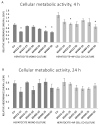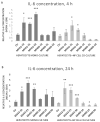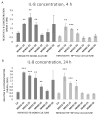The Effects of Matriptase Inhibition on the Inflammatory and Redox Homeostasis of Chicken Hepatic Cell Culture Models
- PMID: 33919461
- PMCID: PMC8143509
- DOI: 10.3390/biomedicines9050450
The Effects of Matriptase Inhibition on the Inflammatory and Redox Homeostasis of Chicken Hepatic Cell Culture Models
Abstract
The function of the transmembrane serine protease matriptase is well described in mammals, but it has not been elucidated in avian species yet. Hence, the aim of the present study was to assess the effects of the 3-amidinophenylalanine (3-AphA)-type matriptase inhibitors MI432 and MI460 on the inflammatory and oxidative state of chicken primary hepatocyte mono-cultures and hepatocyte-nonparenchymal cell co-cultures, the latter serving as a proper model of hepatic inflammation in birds. Cell cultures were exposed to MI432 and MI460 for 4 and 24 h at 10, 25, and 50 µM concentrations, and thereafter the cellular metabolic activity, extracellular interleukin (IL-)6, IL-8, H2O2 and malondialdehyde concentrations were monitored. Both inhibitors caused a transient moderate reduction in the metabolic activity following 4 h exposure, which was restored after 24 h, reflecting the fast hepatic adaptation potential to matriptase inhibitor administration. Furthermore, MI432 triggered an intense elevation in the cellular proinflammatory IL-6 and IL-8 production after both incubation times in all concentrations, which was not coupled to enhanced oxidative stress and lipid peroxidation based on unchanged H2O2 production, malondialdehyde levels and glutathione peroxidase activity. These data suggest that physiological matriptase activities might have a key function in retaining the metabolic and inflammatory homeostasis of the liver in chicken, without being a major modulator of the hepatocellular redox state.
Keywords: liver; oxidative stress; poultry; proinflammatory cytokines; serine proteases.
Conflict of interest statement
The authors declare no conflict of interest. The funders had no role in the design of the study; in the collection, analyses, or interpretation of data; in the writing of the manuscript; or in the decision to publish the results.
Figures








Similar articles
-
Effects of Acute Heat Stress on a Newly Established Chicken Hepatocyte-Nonparenchymal Cell Co-Culture Model.Animals (Basel). 2020 Mar 1;10(3):409. doi: 10.3390/ani10030409. Animals (Basel). 2020. PMID: 32121577 Free PMC article.
-
Cellular Effects of T-2 Toxin on Primary Hepatic Cell Culture Models of Chickens.Toxins (Basel). 2020 Jan 13;12(1):46. doi: 10.3390/toxins12010046. Toxins (Basel). 2020. PMID: 31941063 Free PMC article.
-
3-Amidinophenylalanine-derived matriptase inhibitors can modulate hepcidin production in vitro.Naunyn Schmiedebergs Arch Pharmacol. 2020 Mar;393(3):511-520. doi: 10.1007/s00210-019-01743-x. Epub 2019 Oct 28. Naunyn Schmiedebergs Arch Pharmacol. 2020. PMID: 31659405 Free PMC article.
-
Cooperation of liver cells in health and disease.Adv Anat Embryol Cell Biol. 2001;161:III-XIII, 1-151. doi: 10.1007/978-3-642-56553-3. Adv Anat Embryol Cell Biol. 2001. PMID: 11729749 Review.
-
Recent progress on inhibitors of the type II transmembrane serine proteases, hepsin, matriptase and matriptase-2.Future Med Chem. 2019 Apr;11(7):743-769. doi: 10.4155/fmc-2018-0446. Epub 2019 Apr 4. Future Med Chem. 2019. PMID: 30945556 Review.
Cited by
-
Interspecies Comparisons of the Effects of Potential Antiviral 3-Amidinophenylalanine Derivatives on Cytochrome P450 1A2 Isoenzyme.Vet Sci. 2022 Mar 23;9(4):156. doi: 10.3390/vetsci9040156. Vet Sci. 2022. PMID: 35448654 Free PMC article.
-
Comparative cryopreservation of bovine and porcine primary hepatocytes.Front Vet Sci. 2023 Aug 8;10:1211135. doi: 10.3389/fvets.2023.1211135. eCollection 2023. Front Vet Sci. 2023. PMID: 37614462 Free PMC article.
References
-
- Shi Y.E., Torri J., Yieh L., Wellstein A., Lippman M.E., Dickson R.B. Identification and characterization of a novel matrix-degrading protease from hormone-dependent human breast cancer cells. Cancer Res. 1993;53:1409–1415. - PubMed
-
- Hooper J.D., Campagnolo L., Goodarzi G., Truong T.N., Stuhlmann H., Quigley J.P. Mouse matriptase-2: Identification, characterization and comparative mRNA expression analysis with mouse hepsin in adult and embryonic tissues. Biochem. J. 2003;373:689–702. doi: 10.1042/bj20030390. - DOI - PMC - PubMed
-
- List K., Haudenschild C.C., Szabo R., Chen W., Wahl S.M., Swaim W., Engelholm L.H., Behrendt N., Bugge T.H. Matriptase/MT-SP1 is required for postnatal survival, epidermal barrier function, hair follicle development, and thymic homeostasis. Oncogene. 2002;21:3765–3779. doi: 10.1038/sj.onc.1205502. - DOI - PubMed
Grants and funding
LinkOut - more resources
Full Text Sources
Other Literature Sources

